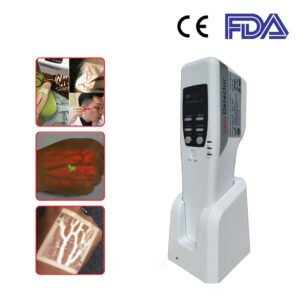Vein Finders and Deep Vein Thrombosis
Deep vein thrombosis (DVT) occurs when a blood clot (thrombus) forms in one or more of the deep veins in your body, usually in your legs. Patients can get DVT if they have certain medical conditions that affect how their blood clots.
Causes of Deep Vein Thrombosis (DVT)
Surgery, particularly surgery of the hip or leg, or abdominal surgery.
Trauma or bone fracture.
A long period of bed rest or sitting for a long time (e.g., on an airplane or in a car)
Cancer.
Pregnancy.
Birth control pills or hormones taken for symptoms of menopause.
Varicose veins.
DVT signs and symptoms can include:
- Swelling in the affected leg. Rarely, there’s swelling in both legs.
- Pain in your leg. The pain often starts in your calf and can feel like cramping or soreness.
- Red or discolored skin on the leg.
- A feeling of warmth in the affected leg.
Using vein finders during diagnosis will show any clots in the deep veins.
Also,The use of a vein finder would make it easier for the phlebotomist to discover the vein, reducing the risk of a pre-analytical error in the specimen collection and causing the patient even more misery and pain.
In reality, due to the elderly’s deteriorating skin, blood drawing can be difficult. Their skin becomes thinner, dryer, and more delicate. Furthermore, when the blood vessels grow more sensitive, a venipuncture failure might cause these tiny blood vessels to burst readily. As a result, bruising, swelling, and even bleeding may occur beneath the skin and that’s what DVT patients already suffer from.
The FDA Portable Vein Detector SIFVEIN-5.2 is intended specifically for situations where finding a vein is challenging or requires extra concentration and caution. The SIFVEIN-5.2 allows veins to be seen clearly in a depth of 10 mm under the skin, regardless of the patient’s age, skin color, or obesity level.
It also has a depth recognition mode that improves judgment of the vein’s depth, as well as three colors (red, green, and white) that can be switched at will depending on the light in the room and the skin tone of the patient, making the vein more visible, easier to access, and increasing clinical accuracy. As a result, any prospective failure diagnosis is eliminated, as well as anxiety, tension, and pain to the DVT patient.
Vein detectors, such as SIFSOF’s reliable and clear vein illuminator FDA Portable Vein Detector SIFVEIN-5.2, have so far proven their effectiveness during this difficult IV procedure.
The vein finder SIFVEIN-5.2 is a non-invasive, portable gadget that shines near-infrared light onto the patient’s skin, mapping out the targeted deep leg veins that would otherwise be invisible to the naked eye.
To summarize, venipuncture would be a lot easier if a vein finder was employed. Phlebotomists, nurses, and doctors can ensure the procedure’s success while lowering the number of failed needle attempts and patient discomfort.
Reference: Deep vein thrombosis (DVT)
Disclaimer: Although the information we provide is used by different doctors and medical staff to perform their procedures and clinical applications, the information contained in this article is for consideration only. SIFSOF is not responsible neither for the misuse of the device nor for the wrong or random generalizability of the device in all clinical applications or procedures mentioned in our articles. Users must have the proper training and skills to perform the procedure with each vein finder device.
The products mentioned in this article are only for sale to medical staff (doctors, nurses, certified practitioners, etc.) or to private users assisted by or under the supervision of a medical professional.

